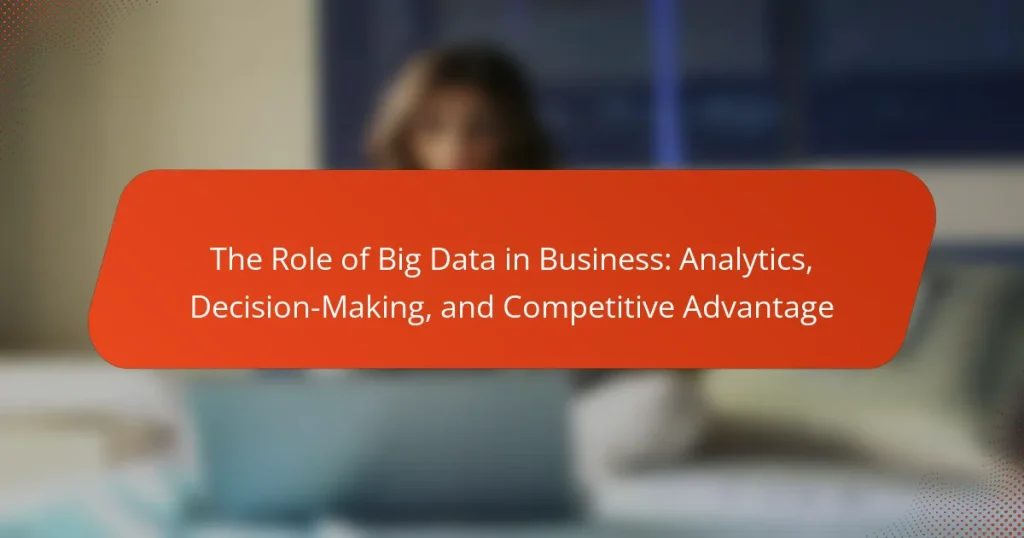Big Data is a critical component in modern business operations, facilitating data-driven decision-making through the analysis of extensive structured and unstructured data. This article explores how organizations utilize Big Data to identify trends and patterns that enhance strategic planning and operational efficiency. It highlights the impact of advanced analytics techniques, such as machine learning, on productivity and customer satisfaction. Additionally, the article discusses the competitive advantages gained by businesses that effectively leverage Big Data, including improved forecasting, risk management, and customer insights, underscoring the importance of data analytics in today’s market.
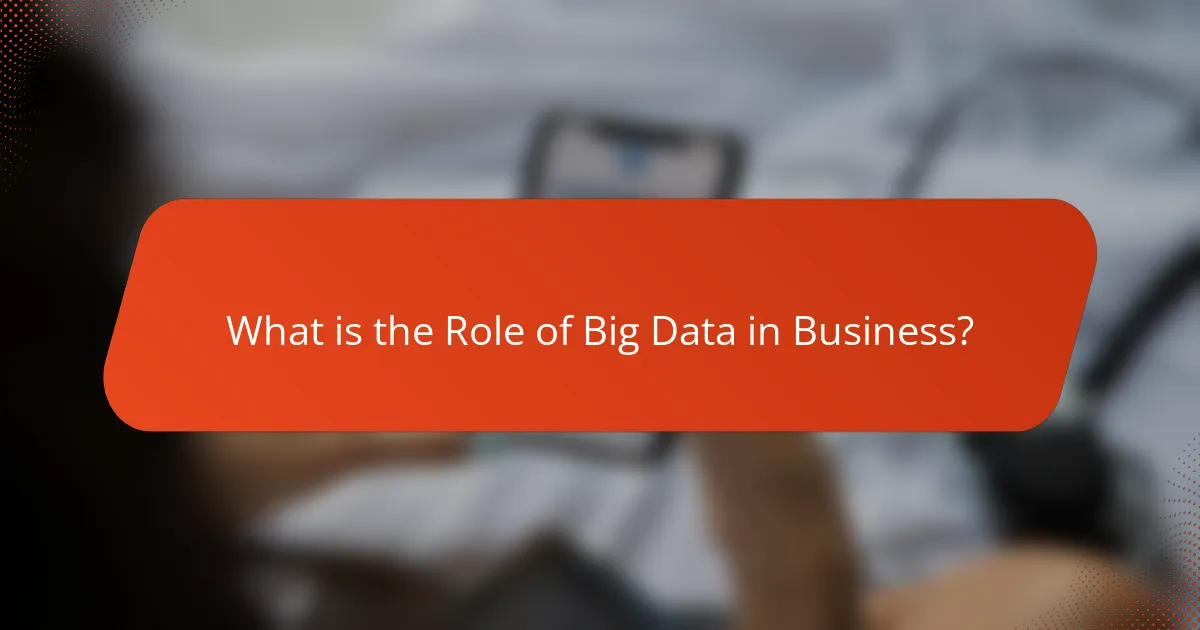
What is the Role of Big Data in Business?
Big data plays a crucial role in business by enabling data-driven decision-making. It allows companies to analyze vast amounts of information quickly and effectively. Businesses can identify trends and patterns that inform strategy. For instance, 90% of the world’s data was created in the last two years, highlighting the exponential growth of data. Companies leveraging big data can enhance customer experiences by personalizing services. Additionally, data analytics can improve operational efficiency and reduce costs. According to a McKinsey report, organizations that utilize big data can increase productivity by up to 5-6%. This competitive advantage is essential in today’s data-driven market.
How does Big Data influence business operations?
Big Data significantly influences business operations by enabling data-driven decision-making. It allows companies to analyze vast amounts of data quickly. This analysis leads to improved efficiency and productivity. For instance, businesses can identify trends and customer preferences. By leveraging these insights, companies can optimize their marketing strategies. According to a McKinsey report, organizations that utilize Big Data effectively can increase their operating margins by up to 60%. Additionally, Big Data helps in risk management by predicting potential challenges. Overall, the integration of Big Data enhances competitiveness in the market.
What are the key components of Big Data in a business context?
The key components of Big Data in a business context include volume, velocity, variety, veracity, and value. Volume refers to the vast amounts of data generated every second, often in terabytes or petabytes. Velocity indicates the speed at which data is created and processed, which can be real-time or near real-time. Variety encompasses the different types of data, including structured, semi-structured, and unstructured formats. Veracity addresses the quality and reliability of the data, ensuring it is accurate and trustworthy. Value represents the insights and benefits that can be derived from analyzing Big Data, driving informed decision-making and competitive advantage. These components are essential for businesses to leverage data effectively and gain insights that inform strategy and operations.
How do businesses collect and store Big Data?
Businesses collect Big Data through various methods such as online transactions, social media interactions, and sensor data from IoT devices. They utilize data collection tools like web scraping, surveys, and APIs to gather information. Data is often stored in cloud-based solutions or on-premises servers, depending on the company’s infrastructure. Storage solutions include databases like Hadoop and NoSQL systems. These technologies allow businesses to handle large volumes of data efficiently. According to a report by Statista, the global big data market is expected to reach $103 billion by 2027, highlighting the growing importance of effective data storage solutions.
Why is Big Data important for modern businesses?
Big Data is crucial for modern businesses because it enables data-driven decision-making. Organizations can analyze vast amounts of data to identify trends and patterns. This insight helps in understanding customer behavior and preferences. According to a McKinsey report, companies that leverage Big Data can increase their productivity by up to 6%. Additionally, Big Data enhances operational efficiency by optimizing processes. Businesses can predict market trends and mitigate risks through advanced analytics. Furthermore, it fosters innovation by uncovering new opportunities. In summary, Big Data provides a competitive advantage in today’s data-centric market.
What advantages does Big Data offer in decision-making?
Big Data offers significant advantages in decision-making. It enables organizations to analyze vast amounts of information quickly. This analysis leads to data-driven insights. Companies can identify patterns and trends effectively. Enhanced accuracy in forecasting is another benefit. Businesses can make informed decisions based on real-time data. Additionally, Big Data improves customer segmentation and targeting. According to a McKinsey report, data-driven organizations are 23 times more likely to acquire customers. This demonstrates the impact of Big Data on competitive advantage in decision-making.
How does Big Data contribute to understanding customer behavior?
Big Data enhances the understanding of customer behavior by analyzing vast amounts of data from various sources. It enables businesses to identify patterns in purchasing habits and preferences. For example, companies can track online interactions, such as clicks and purchases. This data reveals insights into customer preferences and trends. Additionally, predictive analytics can forecast future buying behaviors based on historical data. Research shows that 73% of organizations believe data-driven marketing is crucial for success. By leveraging Big Data, businesses can tailor their marketing strategies effectively. This leads to improved customer satisfaction and increased loyalty.
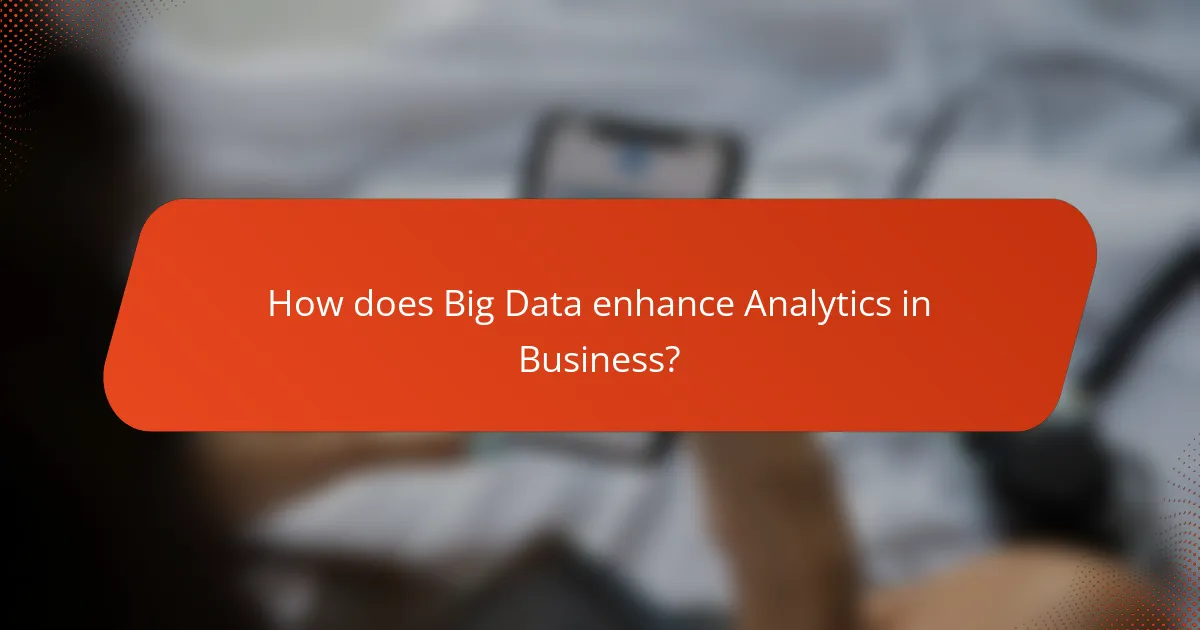
How does Big Data enhance Analytics in Business?
Big Data enhances analytics in business by providing vast amounts of structured and unstructured data. This data allows businesses to identify patterns and trends that were previously undetectable. Advanced analytics techniques, such as machine learning, can process this data efficiently. As a result, companies can make data-driven decisions quickly. For example, a study by McKinsey found that organizations using data analytics can increase their productivity by up to 6%. Additionally, real-time data analysis enables businesses to respond to market changes instantly. This agility gives companies a competitive advantage in their respective industries.
What types of analytics are powered by Big Data?
Descriptive analytics, predictive analytics, and prescriptive analytics are the main types of analytics powered by Big Data. Descriptive analytics focuses on summarizing historical data to identify trends and patterns. Predictive analytics uses statistical algorithms and machine learning techniques to forecast future outcomes based on historical data. Prescriptive analytics recommends actions based on data analysis and predictive modeling. According to a report by McKinsey & Company, organizations that leverage Big Data analytics can improve their decision-making processes and gain a competitive edge.
How does descriptive analytics utilize Big Data?
Descriptive analytics utilizes Big Data by analyzing historical data to identify trends and patterns. It processes large datasets to summarize past events and performance metrics. This analysis helps businesses understand their operational efficiency and customer behavior. Tools like data visualization aid in presenting findings clearly. For example, companies can track sales trends over time. This insight allows for informed decision-making and strategy development. According to a study by IBM, organizations using descriptive analytics can improve operational efficiency by up to 20%. This demonstrates the significant impact of descriptive analytics on leveraging Big Data for business insights.
What role does predictive analytics play in leveraging Big Data?
Predictive analytics plays a crucial role in leveraging Big Data by transforming vast datasets into actionable insights. It utilizes statistical algorithms and machine learning techniques to identify patterns and trends within the data. This process enables businesses to forecast future outcomes based on historical data. For instance, companies can predict customer behavior, optimize inventory levels, and enhance marketing strategies. According to a study by McKinsey, organizations that effectively use predictive analytics can increase their profitability by up to 10%. This demonstrates the significant impact predictive analytics has on decision-making and competitive advantage in the business landscape.
How can businesses implement Big Data analytics effectively?
Businesses can implement Big Data analytics effectively by establishing clear objectives and selecting the right tools. They should identify key performance indicators that align with their goals. Data collection methods must be robust, ensuring data quality and relevance. Training staff on data analysis tools enhances their ability to derive insights. Integrating analytics into decision-making processes fosters a data-driven culture. Regularly reviewing and refining analytics strategies is essential for continuous improvement. According to a McKinsey report, companies that leverage data-driven decision-making are 23 times more likely to acquire customers.
What tools and technologies are essential for Big Data analytics?
Essential tools and technologies for Big Data analytics include Hadoop, Spark, and NoSQL databases. Hadoop is an open-source framework that allows for distributed storage and processing of large data sets. Apache Spark provides fast data processing capabilities and supports in-memory computing. NoSQL databases, like MongoDB and Cassandra, enable flexible data storage and retrieval for unstructured data. Additionally, data visualization tools such as Tableau and Power BI help in interpreting complex data insights. These tools collectively enhance data analysis efficiency and effectiveness in business decision-making.
How do businesses ensure data quality in analytics?
Businesses ensure data quality in analytics through various methods. They implement data validation techniques to check for accuracy. This includes verifying data against trusted sources. Data cleansing processes are employed to remove inaccuracies and duplicates. Regular audits are conducted to assess data integrity. Training staff on data entry best practices enhances data quality. Utilizing automated tools for data monitoring helps identify issues promptly. Establishing clear data governance policies ensures compliance and consistency. These practices are essential for reliable analytics and informed decision-making.
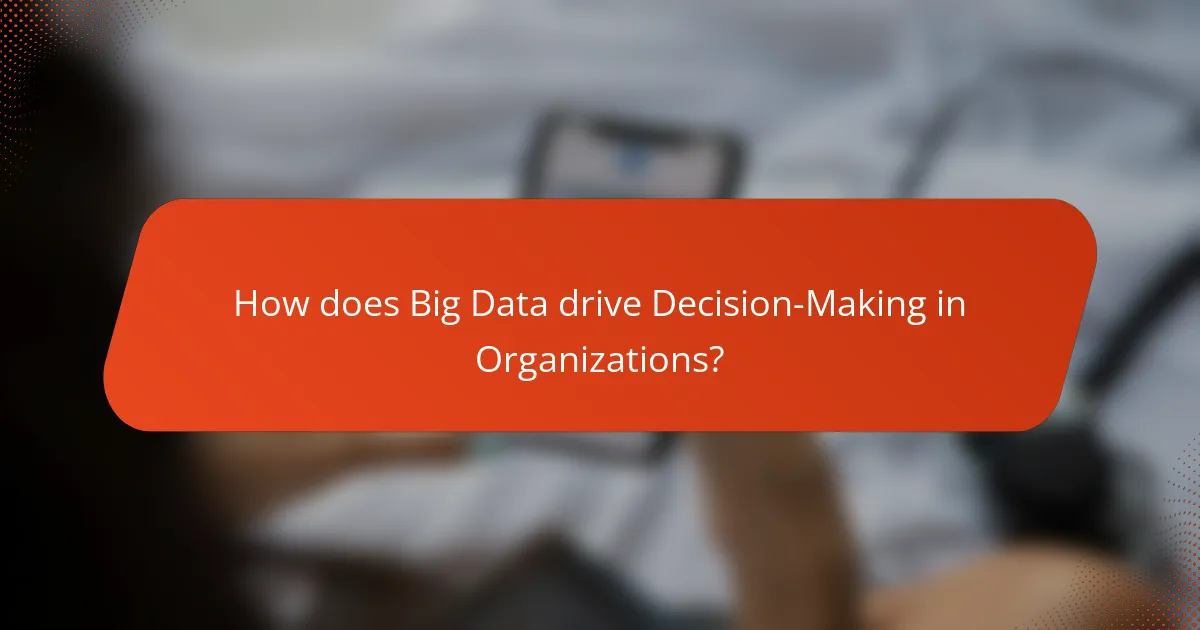
How does Big Data drive Decision-Making in Organizations?
Big Data drives decision-making in organizations by enabling data-driven insights. Organizations analyze vast amounts of data to identify patterns and trends. These insights inform strategic planning and operational improvements. For example, companies like Netflix use viewer data to tailor content offerings. This leads to increased viewer satisfaction and retention. Additionally, businesses leverage predictive analytics to forecast market trends. This allows for proactive decision-making rather than reactive measures. According to a McKinsey report, data-driven organizations are 23 times more likely to acquire customers. This statistic underscores the competitive advantage gained through effective use of Big Data.
What are the key decision-making processes enhanced by Big Data?
Big Data enhances key decision-making processes such as predictive analytics, customer segmentation, and operational efficiency. Predictive analytics uses historical data to forecast future trends. Companies can make informed decisions based on these predictions. Customer segmentation enables businesses to tailor marketing strategies to specific demographics. This personalization increases engagement and conversion rates. Operational efficiency is improved by analyzing workflow data to identify bottlenecks. Companies can optimize resources and reduce costs through these insights. According to a McKinsey report, organizations that leverage Big Data effectively can improve their profitability by up to 60%.
How does data-driven decision-making differ from traditional methods?
Data-driven decision-making relies on quantitative data analysis, while traditional methods often depend on intuition and experience. In data-driven approaches, decisions are supported by statistical evidence and predictive analytics. This method enhances accuracy and reduces bias in decision-making processes. Traditional methods may overlook important data insights, leading to less informed choices. A study by McKinsey & Company found that companies using data-driven strategies are 23 times more likely to acquire customers. Additionally, data-driven organizations can respond more swiftly to market changes, improving their competitive edge.
What challenges do organizations face in making decisions based on Big Data?
Organizations face several challenges in making decisions based on Big Data. One major challenge is data quality. Inaccurate or incomplete data can lead to poor decision-making. Another challenge is data integration. Combining data from various sources can be complex and time-consuming. Additionally, organizations often struggle with data privacy and security. Protecting sensitive information is crucial yet challenging. There is also a skills gap in the workforce. Many employees lack the necessary expertise to analyze Big Data effectively. Finally, organizations may encounter resistance to change. Employees may be hesitant to adopt data-driven decision-making practices. These challenges can hinder the effective use of Big Data in decision-making processes.
How can businesses cultivate a data-driven culture?
Businesses can cultivate a data-driven culture by prioritizing data literacy among employees. Training programs should focus on enhancing skills in data analysis and interpretation. Access to data should be democratized across all levels of the organization. This encourages employees to utilize data in their decision-making processes. Leadership must model data-driven behaviors to set a precedent. Regularly sharing success stories related to data usage reinforces its value. Implementing tools that facilitate data access can also drive engagement. According to a study by McKinsey, organizations that embrace data-driven decision-making are 23 times more likely to acquire customers.
What training and resources are needed for staff to leverage Big Data?
Staff need training in data analytics, programming, and data visualization to leverage Big Data effectively. Courses in statistics and machine learning are also beneficial. Resources such as software tools, data management systems, and cloud storage solutions are essential. Access to Big Data platforms like Hadoop or Spark enhances data processing capabilities. Ongoing workshops and certifications help staff stay updated on industry trends. Companies often invest in training programs to build these skills internally. Research shows that organizations with trained staff can increase their data-driven decision-making efficiency by up to 5 times.
How can leadership support data-driven decision-making?
Leadership can support data-driven decision-making by fostering a culture that values data. They should encourage teams to utilize data analytics in their processes. Providing access to relevant data tools is essential for this initiative. Leadership must also prioritize training employees on data interpretation skills. Regularly communicating the importance of data in strategic decisions reinforces this culture. By setting clear expectations for data usage, leaders can guide teams effectively. Furthermore, investing in data infrastructure enhances the organization’s analytical capabilities. According to a McKinsey report, companies that leverage data-driven decision-making are 23 times more likely to acquire customers.
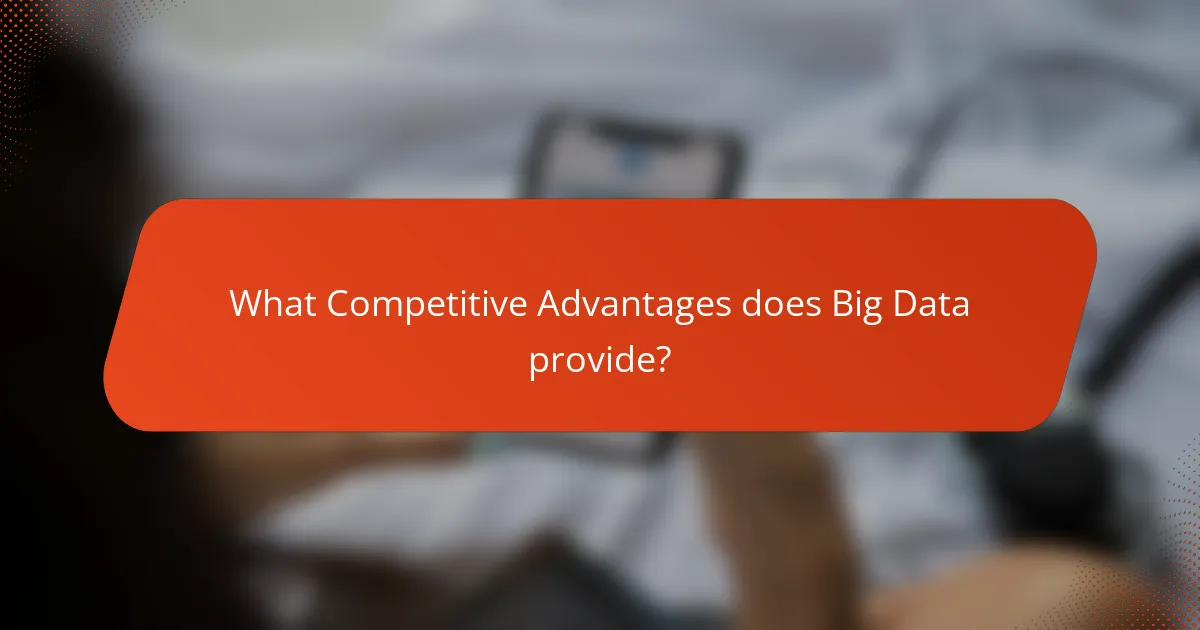
What Competitive Advantages does Big Data provide?
Big Data provides significant competitive advantages by enabling data-driven decision-making. Organizations can analyze vast amounts of data to identify trends and patterns. This leads to more accurate forecasting and improved operational efficiency. Companies leveraging Big Data often experience enhanced customer insights. They can tailor products and services to meet specific consumer needs. Additionally, Big Data facilitates better risk management through predictive analytics. Research shows that businesses utilizing Big Data can outperform competitors by up to 8% in productivity. This demonstrates the tangible benefits of incorporating Big Data into business strategies.
How does Big Data impact market competitiveness?
Big Data significantly impacts market competitiveness by enabling businesses to make data-driven decisions. Companies can analyze vast amounts of data to understand consumer behavior. This insight allows for targeted marketing strategies and personalized customer experiences. According to a McKinsey report, data-driven organizations are 23 times more likely to acquire customers. They are also 6 times more likely to retain customers. Furthermore, Big Data helps identify market trends and opportunities. This capability allows businesses to innovate and stay ahead of competitors. In summary, leveraging Big Data enhances efficiency and strategic planning in a competitive market.
What unique insights can Big Data provide for strategic planning?
Big Data provides unique insights for strategic planning by uncovering patterns and trends in large datasets. These insights enable organizations to make data-driven decisions. For example, companies can analyze consumer behavior to tailor their products and services effectively. Additionally, Big Data allows for predictive analytics, helping businesses forecast market trends and adjust strategies proactively. A study by McKinsey found that companies leveraging Big Data can improve their operational efficiency by up to 15-20%. This data-driven approach leads to more accurate risk assessments and enhanced competitive advantage.
How can businesses use Big Data to identify new market opportunities?
Businesses can use Big Data to identify new market opportunities by analyzing consumer behavior and market trends. They can collect data from various sources such as social media, sales transactions, and customer feedback. This data reveals insights into customer preferences and emerging market needs. For example, a study by McKinsey & Company found that data-driven organizations are 23 times more likely to acquire customers. Additionally, predictive analytics tools can forecast future trends based on historical data. By leveraging these insights, businesses can tailor their products and marketing strategies effectively. This targeted approach increases the likelihood of capturing new market segments.
What are the best practices for utilizing Big Data for competitive advantage?
Utilizing Big Data for competitive advantage involves several best practices. First, businesses should establish clear objectives for data use. This ensures that data analysis aligns with strategic goals. Second, integrating data from diverse sources enhances insights. Combining internal and external data provides a comprehensive view. Third, investing in advanced analytics tools is crucial. These tools enable deeper analysis and predictive modeling. Fourth, fostering a data-driven culture is essential. Employees should be trained to interpret data effectively. Fifth, ensuring data quality and governance cannot be overlooked. High-quality data leads to reliable insights. Lastly, regularly reviewing and adapting strategies based on data insights keeps businesses agile. According to a McKinsey report, data-driven organizations are 23 times more likely to acquire customers. This statistic illustrates the significant impact of effective Big Data utilization.
How can businesses measure the ROI of Big Data initiatives?
Businesses can measure the ROI of Big Data initiatives by analyzing cost savings and revenue growth. They assess the initial investment in Big Data technologies and compare it to the financial benefits gained. Key performance indicators (KPIs) such as increased sales, reduced operational costs, and improved customer satisfaction provide measurable outcomes.
For instance, a study by McKinsey found that organizations leveraging Big Data can increase their operating margins by 60%. Additionally, businesses can calculate ROI by using the formula: (Net Profit from Big Data – Cost of Big Data) / Cost of Big Data. This approach quantifies the financial impact of Big Data investments effectively.
What ethical considerations should businesses keep in mind when using Big Data?
Businesses must prioritize user privacy when utilizing Big Data. This includes obtaining informed consent from individuals whose data is being collected. Transparency about data usage is essential. Companies should clearly communicate how data will be utilized and stored. Data security measures must be robust to prevent breaches. Ethical data handling includes anonymizing personal information to protect identities. Compliance with regulations, such as GDPR, is mandatory for legal and ethical operations. Regular audits of data practices can help maintain ethical standards. These considerations foster trust and protect both consumers and businesses.
What are practical tips for integrating Big Data into business strategy?
Integrating Big Data into business strategy requires a structured approach. First, identify key business objectives that can benefit from data insights. Next, invest in the right technology and tools for data collection and analysis. Ensure data quality by implementing robust data governance practices. Train staff on data literacy to enhance their ability to interpret data effectively. Foster a data-driven culture by encouraging data-informed decision-making at all levels. Collaborate with data scientists or analysts to leverage advanced analytics techniques. Regularly review and adjust strategies based on data insights to stay aligned with business goals. According to a McKinsey report, companies that effectively use data are 23 times more likely to acquire customers.
The main entity of this article is Big Data and its role in business. The article provides an overview of how Big Data enables data-driven decision-making, enhances analytics, and offers competitive advantages to organizations. It discusses key components of Big Data, methods for collection and storage, and the importance of data quality. Additionally, it covers the impact of Big Data on understanding customer behavior, improving operational efficiency, and identifying new market opportunities, while also addressing challenges and ethical considerations in its implementation. The insights presented underscore the significance of leveraging Big Data to drive strategic planning and decision-making in a competitive market.
